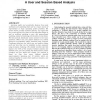Free Online Productivity Tools
i2Speak
i2Symbol
i2OCR
iTex2Img
iWeb2Print
iWeb2Shot
i2Type
iPdf2Split
iPdf2Merge
i2Bopomofo
i2Arabic
i2Style
i2Image
i2PDF
iLatex2Rtf
Sci2ools
ICS
2005
Tsinghua U.
2005
Tsinghua U.
What is worth learning from parallel workloads?: a user and session based analysis
Learning useful and predictable features from past workloads and exploiting them well is a major source of improvement in many operating system problems. We review known parallel workload features, and argue that the correct approach for future on-line algorithm design as well as workload modeling is user- and session-based modeling, instead of analyzing jobs directly as done today. We then provide statistically sound answers to two basic questions: Which user and session features are central enough to be potentially useful, answered using Principal Component Analysis, and which user and session classes exist and how they can be identified on-line, answered using K-means clustering. We identify variable sets that explain over 80% of the variance between sessions and between users, and also identify five stable session classes (clusters) and four stable user classes. Our analysis is based on logs from seven different parallel supercomputers, spanning over 87 months, which are analyzed ...
ICS 2005 | Session Classes | Session-based Modeling | Theoretical Computer Science | Workload Modeling |
| Added | 27 Jun 2010 |
| Updated | 27 Jun 2010 |
| Type | Conference |
| Year | 2005 |
| Where | ICS |
| Authors | Julia Zilber, Ofer Amit, David Talby |
Comments (0)

